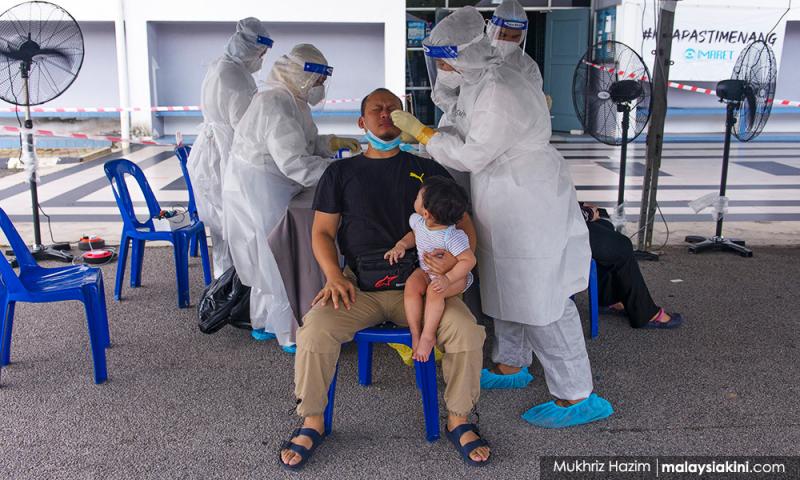LETTER | Managing the nation's Covid-19 response, responsibly
LETTER | With position comes power. Power to rule and govern. What more with the emergency declared?
While Malaysians grapple with the constant barrage of MCOs, CMCOs, EMCOs, and RMCOs, businesses big and small are affected so badly to the point that some have even disappeared forever. The constant announcements of help from the government never did reach some of them.
More interestingly, what are those in authority doing to get to the source of the problem?
Take Australia and New Zealand for example. While they dispensed the painful medicine early on in the pandemic by ensuring strict lockdowns, they are now seeing single-digit cases and are generally acknowledged as the best in managing the virus that has set upon us for one year now.
Although Malaysia has now received the vaccine, the crucial ‘herd immunity' point will not be seen until a significant percentage of the population is immunised. So, yet again has the government done what is within its powers to manage the situation? In short, dare I say not enough!
Let’s look into what was said by the Health Ministry director-general (DG) early on in the pandemic, to achieve the crucial ‘low infection’ rate.
‘Early testing’ or ‘Ujian saringan’ was mentioned many times in order to identify those who might have been exposed to the virus but did not show any symptoms. This was said to be crucial so that the possibility of infection by these asymptomatic individuals will be minimised. In fact, the reopening of “quarantine centres” such as Maeps was meant to achieve this.
Test and identify, isolate and treat. Fact: The DG himself said that this is to relieve the pressure currently felt by the hospital teams who do not have enough beds to treat severe cases if more cases keep emerging. Sadly, this early testing may not be reaching other states, such as Perak which has recently seen a four-digit record of cases - 1,215 cases on Feb 21, 2021.
With the reopening of economic sectors, to ensure that the economy remains active after undergoing yet another MCO, workplaces become a real danger. Again, as mentioned by the DG, ‘workplace clusters’ are becoming the real hotspots of infection. Why?
A false sense of safety where exposure to carriers and asymptomatic patients mean possibilities of infection are higher. Sadly, worker dormitories and staff quarters, even those in government such as correctional facilities can become hotspots. Will early screening help? For sure. But has it been done? Not enough!
While the vaccine rollout has begun, one cannot help but feel this is yet another exercise that may not have been well thought out and if I'm not wrong, more can be done to give assurance to the public that the authorities have a well-mapped plan.
Do you know about the rollout plan and what is the approach taken by the government? It has been announced that Perak will receive up to 79,650 doses of the Covid-19 vaccine. Of these, 33,503 doses will be allocated to frontliners through 49 vaccine dispensing centres including Stadium Indera Mulia.
However, with the second phase planned only between April and August for those 60 years old and above including chronic and high-risk groups, what is the plan to manage these groups between now and then?
As a reminder, didn’t the Women, Family, and Community Development Minister mention that certain people in the high-risk group are not part of the ‘first dose’ recipients?
If high risks groups are not part of it, who are they targeting as early recipients other than frontliners? It is no secret that undocumented workers are avoiding the authorities, and if this is so, how will the vaccine reach this crucial group which is by far the biggest contributor to new Covid-19 cases given their cramped living conditions?
For Selangor which has its own task force to proactively increase testing and also creating a ‘Pois’ (Preventing Outbreak at Ignition Site) are testaments that the state government is serious about bringing down the high numbers recorded recently.
Enforcement is lax, notwithstanding the tomfoolery of some who were tasked with manning the roadblocks, which sometimes achieve nothing other than alleged sexual harassment and revealing how they're ill-informed of district boundaries.
Instead, enforcement officials should have been deployed at hotspots, and strict MCOs should have been enforced in districts and areas, rather than a blanketed one.
On one hand, we had the Prime Minister talking about a ‘travel bubble’ with our neighbour Indonesia (which coincidentally continues with high infection numbers). However, not much has been revealed about the safety and mechanisms on how this can be achieved.
Rather, can I suggest, simple state-managed task forces to battle the virus, just as seen in Selangor which is targeted to better manage matters on the ground? It appears Selangor has taken its own measures and it will be a deadly mistake if politics is used as a measure of what is the best way to manage the virus.
High numbers are just indicators and managing them is a sure step to reduce infections based on 'cases by infection' and 'cases by 100,000'. We can expect high population areas to have higher rates of infection, such as India, China, New York, etc. Thus, having 10 cases in a state like Perlis will not be of the same magnitude as 10 cases in Sarawak.
Sadly, we seem to be unable or unwilling to micromanage the virus at this point, here and now.
TERENCE NAIDU is the Pasir Bedamar state assemblyperson for DAP in Perak.
The views expressed here are those of the author/contributor and do not necessarily represent the views of Malaysiakini.
RM12.50 / month
- Unlimited access to award-winning journalism
- Comment and share your opinions on all our articles
- Gift interesting stories to your friends
- Tax deductable
